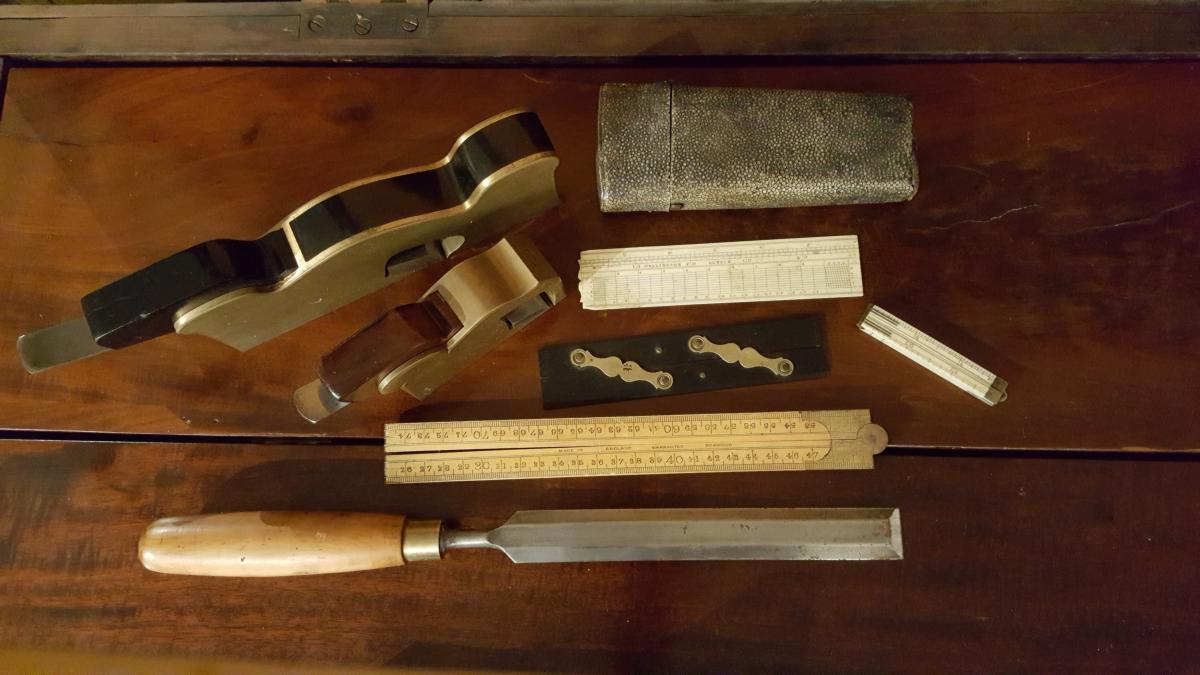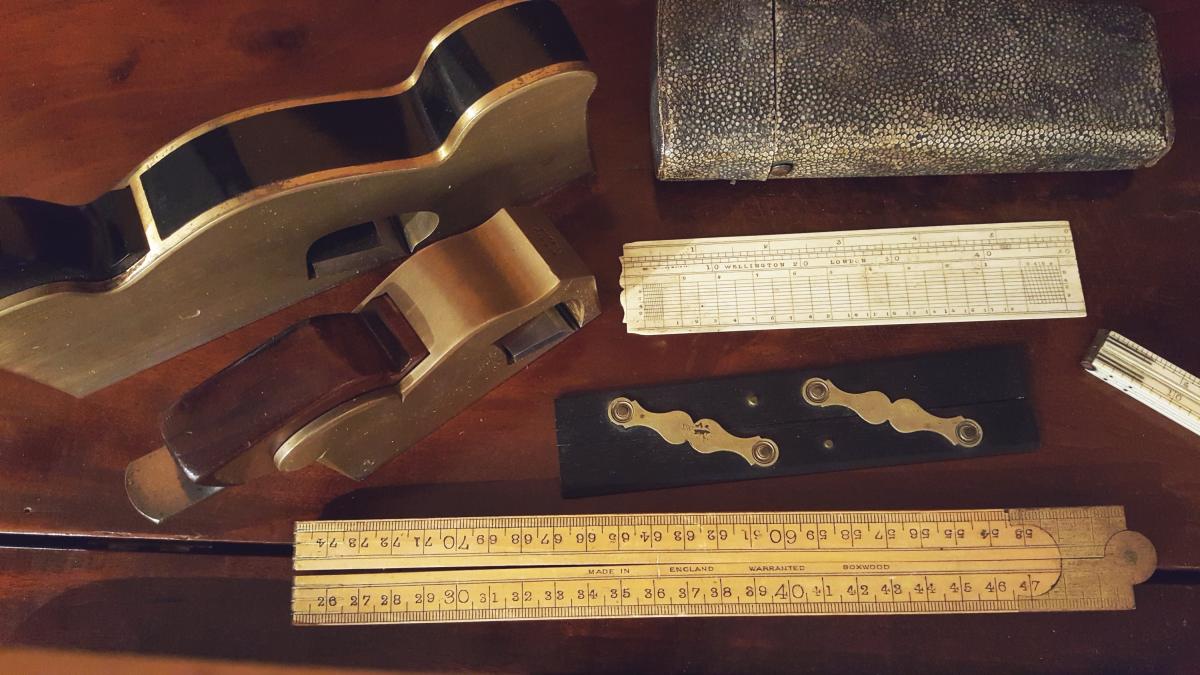
The Convention on International Trade of Endangered Species, or CITES, was developed as an agreement in 1973 to protect endangered species. Restricted materials on the CITES list are not permitted to be imported or exported. The CITES list continue to affect woodworkers in general and perhaps luthiers most of all. I personally believe we shouldn't be killing elephants and cutting down rare, slow-growing trees just so that I could have a fancy rule. Turning ebony or rosewood into flooring for wealthy clients doesn't seem to me to be the best use of those materials either. If you need to cover an instrument case or saw handle to make it resistant to slipping in your hand, there are now much better alternatives than sharkskin. I also understand why the trade in old banned materials such as ivory is largely banned. If it were legal to easily trade old ivory, no doubt all sorts of new ivory would magically appear on the market labeled as "antique."
By the same token I don't blame previous generations for using materials that at the time were neither endangered nor considered unethical to use. My tool collection actually contains a fair number of tools that use materials that fit this description, and I thought it would be interesting to look at them and understand why these materials were used and in what context.
Boxwood is a very slow growing small tree. There are many varieties with subtle differences. Boxwood is a very hard wood with very dense grain and, when freshly cut, a pale yellow color. Because boxwood is so dense, air drying takes years. When I was younger I used some small pieces for modelmaking and it was a pleasure to work with. It takes great detail and burnishes to a high sheen. While English Boxwood has become much harder to get, back in the 19th century and earlier larger pieces were (and are still) in demand for woodwind instruments. Flawed pieces were used for tool handles.
Boxwood rules were made in the millions up to the age of the tape measure, but most of them were not made of English Boxwood but rather various other boxwoods from around the world that were cut down by the boatload. (In the interests of brevity I am not trying to delve too deep into the various species). Drying boxwood results in lots of twists and checks. Consequently at the factory level, about half the boxwood would get scrapped at some point in production of rulers. The boxwood rule in the photo above is almost certainly not English Boxwood, and isn't straight anymore. The boxwood in the handle of the paring chisel above has a fair number of knots and defects that make it unsuitable for instrument making.
Boxwood tool handles were used on higher-end tools that were not meant to be struck. The wood is also pretty brittle so you cannot really force a tang into a handle without a drilling a decently fitting hole first. According to Ray Iles, boxwood handles were held in place with rosin.
Quick Tip (also from Ray): When you make a boxwood handle, it cuts drying time to drill the tang hole when you get the material so the wood can dry out from the inside and outside at the same time.
Brazilian Rosewood and Ebony are two tropical rain forest woods that were used almost exclusively for decorative higher end tools. Plane makers also used Brazilian Rosewood, Cocobolo and Ebony for plane handles. There were also a few makers who made wooden plane bodies out of these materials too. As far as I know, there is no mechanical reason for using these woods. Beech handles would work just as well; the earliest infill planes I have seen used beech infill. The material was always expensive and the infill of an early panel plane I have by Robert Towell (c. 1840) was made of several pieces of rosewood pieced together. Perhaps the rationale for using these woods on expensive metal planes - and not just English infills; Stanleys were very expensive in their time compared to wooden planes - was that the extra cost of fancy woods, compared to the labor and machining of the metal parts and fitting the wood parts, was nominal, and resulted in a fancier, more elegant looking plane. Most English infill planes used Brazilian Rosewood infill, but Norris and other companies sometimes used Ebony on their shoulder, rebate, and bullnose planes.
Fun Fact: A Roman plane was found in England in 2000 with an iron frame and ivory infill.
An interesting point about these woods is that to the modern eye - or my eye in particular - these woods aren't worth the hype. The Norris shoulder and bullnose planes above, which are essentially untouched since they came from the factory in the 1930's, feature Ebony and Rosewood. The Ebony looks like black plastic. The Rosewood is also very plain. Brazilian Rosewood sometimes has great grain, but most of the Brazilian Rosewood tool handles I have are pretty plain. Ebony, if properly selected, is stable and can make a good straight rule and other drafting instruments. Macasscar Ebony can have wonderful figure but it wasn't typically used for tools.
This brings us to the king of exotic materials: Ivory.
Ivory is the dried and seasoned tusk (from elephants, walruses, warthogs, etc.) Elephant ivory was the most prized because it was the largest, but walrus, mastodon, and a host of other ivories were popular. For tools, African elephant ivory was used the most because it comes in larger pieces and when dried properly it is the whitest. It was used for all sorts of decorative purposes. Just about every kind of tool was made at least once with an ivory handle, typically for presentation. Ivory was almost always used for the sheer luxury and decorative aspect. One exception: rules of various kinds used in drafting took advantage of ivory's particular suitability for precision rules. The picture features a folding ivory rules, but focus instead on the picture's six inch ruler that is part of the portable drafting kit. Ivory has three characteristics that made it a perfect material for precision rules: first, as long as you properly season the ivory, you could make thin, very slightly flexible, rulers that would stay pretty flat. Second, ivory is hard and brittle and you can scratch a distinct fine line on it for measuring. Finally, ivory's white color means fine markings are easy to see. Even the best boxwood rules cannot take as fine a line, or are as readable.
The final material in my list is sharkskin -- or Shagreen, as it is also called. The portable drafting case above, which dates from the late 18th century, is actually made of thick paper and paper compartments covered on the outside with a sharkskin layer. Shagreen was commonly used on high end instruments and cases to give not only a waterproof backing but also a textured surface that gave a nice grip.
I have also seen Japanese saws with sharkskin handles.
The first real draft of this blog entry ended or rather stopped with the line above. I like my blog entries to have an ending. A summary. A big point. A sales pitch. Something, anything to tie it all together so I can bring down the curtain and turn the page.
But I am stumped. And that maybe the best conclusion to this blog entry. The materials listed here were expensive and exotic in their own time. Today they are mostly not commercially available, and in many cases ethically challenged. I think knowing why they were once used has historical interest. However, in most cases the tools in question aren't a grand example of craftsmanship - just a standard design in different fancier material. The tools survived the ravages of time because being expensive and in many cases primarily presentation tools, they were put in a drawer and left there. For the modern maker they are at best an attractive anachronism. In the few cases where stability was important these materials are a ringing endorsement of the invention of plastic. I find them cool to look at but I don't learn anything new about tool design from them.

|
 Joel's Blog
Joel's Blog Built-It Blog
Built-It Blog Video Roundup
Video Roundup Classes & Events
Classes & Events Work Magazine
Work Magazine




Thank you for taking the time to educate us on all sort of subject that are always well documented!!
Cheers
David
Joel, although shagreen was made using sharkskin, it was also made with ray skin. Unless I’m mistaken the case is actually covered in ray skin shagreen. The calcium deposits that form the bumps in the skin are very distinctive and sharkskin shagreen looks very different.
When I was 24, I hunted on a farm of pine/spruce trees. The owner told me he was growing them for MY children and grandchildren. At the time, I shrugged off the value of what he was doing.
Destruction of rain forests, elephants and some sharks may cost mankind in the end. Wouldn't it be great if national and state parks planted and maintained some of the hardwood trees that are becoming more rare?
The article above is very insightful, and though the discussion of CITES is perhaps a bit oversimplified, it gets the point across accurately and with fervor. Many thanks for a great contribution.
So some uses of Ivory might not be all about show. (It wasn't always expensive - it was used for piano keys before plastic took over.)
That upcharge really helped the beginning luthier because by splurging on wood across the board Maybe spending 250-400, his guitars would look like a 4000 dollar model, regardless of his reputation.
Blind playing tests are inconclusive, and almost all performed music, even a lot of classical is through some kind of electronics, so I am doubtful on the effect on tone or various kinds of rosewood, with Brazilian at the top. There is a difference vs maple, or mahogany, or other dissimilar woods, at least acoustically without electronics.
Of course when plastic did not exist, one can imagine why people made chess sets out of ebony, and ivory, nothing worked the same detail or polish. These are still great materials for some musical instrument parts as they do things synthetics do not.
Modern day materials may turn out to be stable, but earlier plastics often did not. There is the whole catching on fire, poisoning, shrinking, and going powdery thing, but even modern plastics I have experience with do not age beautifully, for the most part. I guess we will have to see if today's plastic substitutes actually last. A modern day material I love is anodized aluminum. I wish home anodizing was more friendly. Another interesting material that seems to hold up well is diamondwood.